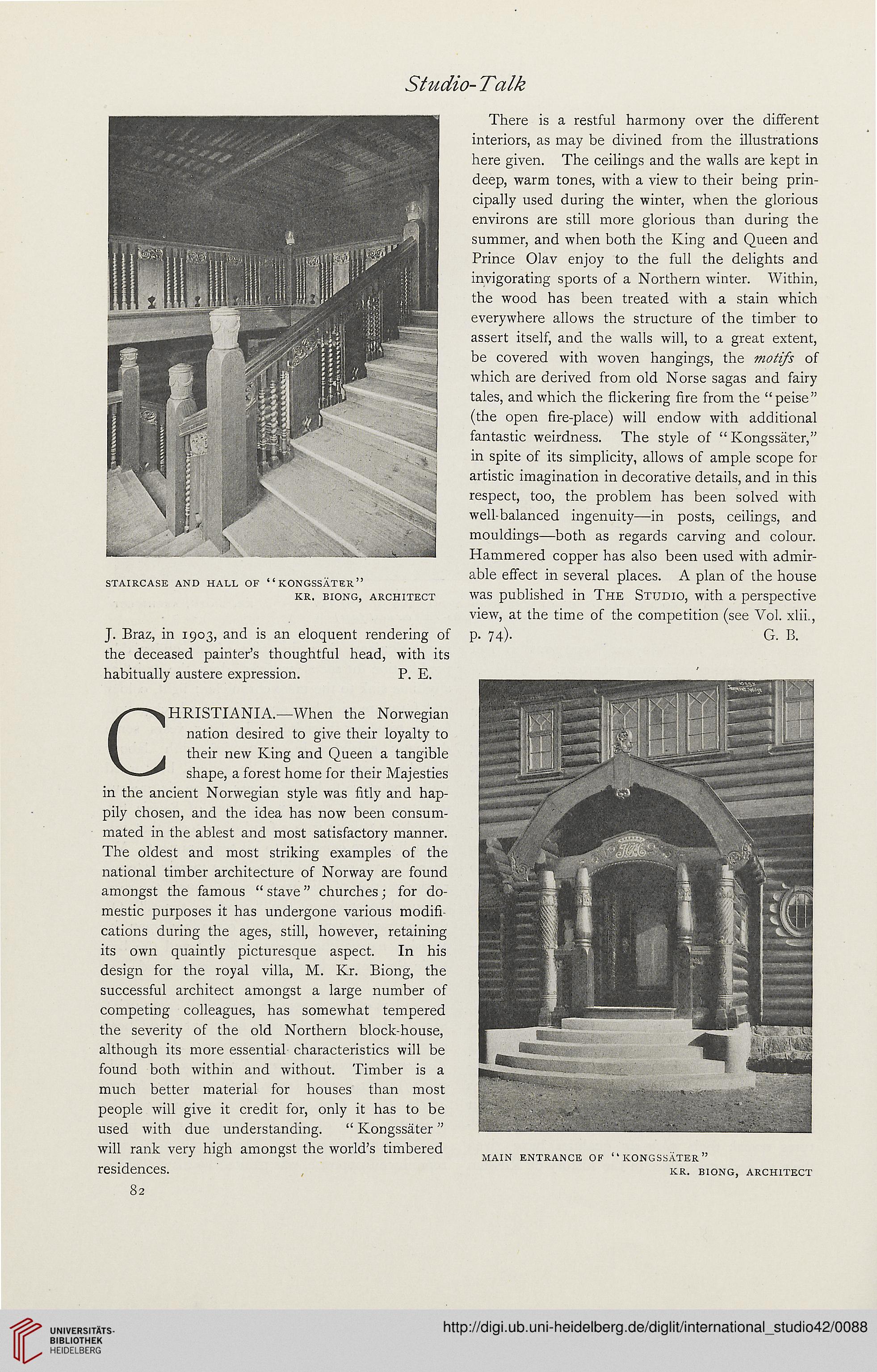Studio- Talk
STAIRCASE AND HALL OF "KONGSSATER"
KR. BIONG, ARCHITECT
J. Braz, in 1903, and is an eloquent rendering of
the deceased painter's thoughtful head, with its
habitually austere expression. P. E.
CHRISTIANIA.—When the Norwegian
nation desired to give their loyalty to
their new King and Queen a tangible
shape, a forest home for their Majesties
in the ancient Norwegian style was fitly and hap-
pily chosen, and the idea has now been consum-
mated in the ablest and most satisfactory manner.
The oldest and most striking examples of the
national timber architecture of Norway are found
amongst the famous "stave" churches; for do-
mestic purposes it has undergone various modifi-
cations during the ages, still, however, retaining
its own quaintly picturesque aspect. In his
design for the royal villa, M. Kr. Biong, the
successful architect amongst a large number of
competing colleagues, has somewhat tempered
the severity of the old Northern block-house,
although its more essential characteristics will be
found both within and without. Timber is a
much better material for houses than most
people will give it credit for, only it has to be
used with due understanding. " Kongssater"
will rank very high amongst the world's timbered
residences.
82
There is a restful harmony over the different
interiors, as may be divined from the illustrations
here given. The ceilings and the walls are kept in
deep, warm tones, with a view to their being prin-
cipally used during the winter, when the glorious
environs are still more glorious than during the
summer, and when both the King and Queen and
Prince Olav enjoy to the full the delights and
invigorating sports of a Northern winter. Within,
the wood has been treated with a stain which
everywhere allows the structure of the timber to
assert itself, and the walls will, to a great extent,
be covered with woven hangings, the motifs of
which are derived from old Norse sagas and fairy
tales, and which the flickering fire from the "peise"
(the open fire-place) will endow with additional
fantastic weirdness. The style of " Kongssater,"
in spite of its simplicity, allows of ample scope for
artistic imagination in decorative details, and in this
respect, too, the problem has been solved with
well-balanced ingenuity—in posts, ceilings, and
mouldings—both as regards carving and colour.
Hammered copper has also been used with admir-
able effect in several places. A plan of the house
was published in The Studio, with a perspective
view, at the time of the competition (see Vol. xlii.,
P- 74)- G. B.
MAIN ENTRANCE OF '1 KONGSSATER "
KR. BIONG, ARCHITECT
STAIRCASE AND HALL OF "KONGSSATER"
KR. BIONG, ARCHITECT
J. Braz, in 1903, and is an eloquent rendering of
the deceased painter's thoughtful head, with its
habitually austere expression. P. E.
CHRISTIANIA.—When the Norwegian
nation desired to give their loyalty to
their new King and Queen a tangible
shape, a forest home for their Majesties
in the ancient Norwegian style was fitly and hap-
pily chosen, and the idea has now been consum-
mated in the ablest and most satisfactory manner.
The oldest and most striking examples of the
national timber architecture of Norway are found
amongst the famous "stave" churches; for do-
mestic purposes it has undergone various modifi-
cations during the ages, still, however, retaining
its own quaintly picturesque aspect. In his
design for the royal villa, M. Kr. Biong, the
successful architect amongst a large number of
competing colleagues, has somewhat tempered
the severity of the old Northern block-house,
although its more essential characteristics will be
found both within and without. Timber is a
much better material for houses than most
people will give it credit for, only it has to be
used with due understanding. " Kongssater"
will rank very high amongst the world's timbered
residences.
82
There is a restful harmony over the different
interiors, as may be divined from the illustrations
here given. The ceilings and the walls are kept in
deep, warm tones, with a view to their being prin-
cipally used during the winter, when the glorious
environs are still more glorious than during the
summer, and when both the King and Queen and
Prince Olav enjoy to the full the delights and
invigorating sports of a Northern winter. Within,
the wood has been treated with a stain which
everywhere allows the structure of the timber to
assert itself, and the walls will, to a great extent,
be covered with woven hangings, the motifs of
which are derived from old Norse sagas and fairy
tales, and which the flickering fire from the "peise"
(the open fire-place) will endow with additional
fantastic weirdness. The style of " Kongssater,"
in spite of its simplicity, allows of ample scope for
artistic imagination in decorative details, and in this
respect, too, the problem has been solved with
well-balanced ingenuity—in posts, ceilings, and
mouldings—both as regards carving and colour.
Hammered copper has also been used with admir-
able effect in several places. A plan of the house
was published in The Studio, with a perspective
view, at the time of the competition (see Vol. xlii.,
P- 74)- G. B.
MAIN ENTRANCE OF '1 KONGSSATER "
KR. BIONG, ARCHITECT




